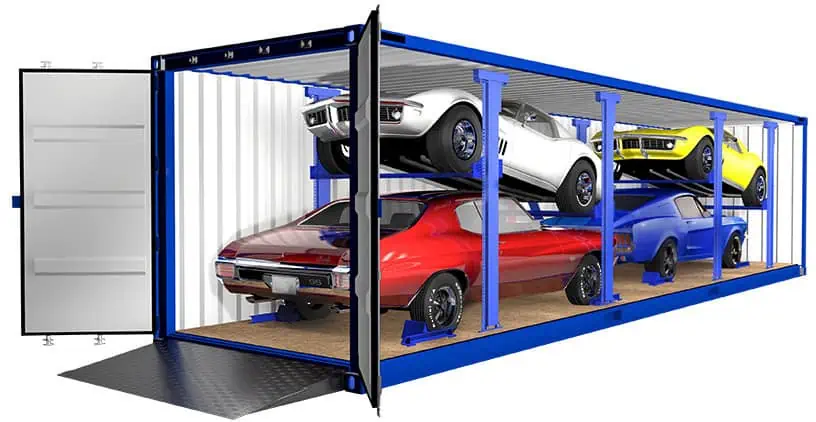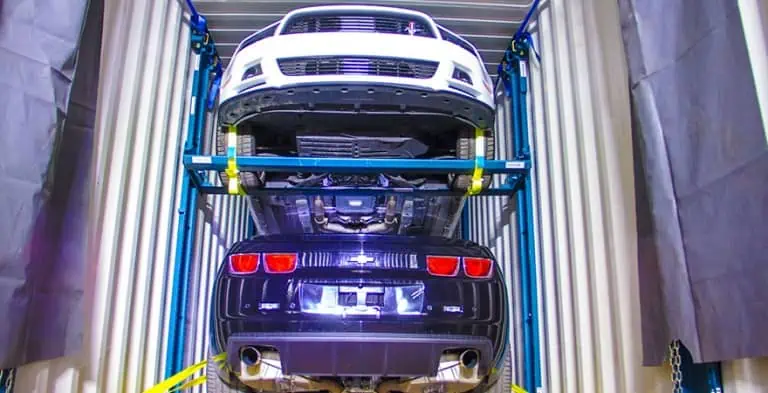Shipping containers offer a reliable and efficient way to transport your car internationally. However, choosing the right size of shipping container is key to ensuring the safe journey of your vehicle. In this article, we will explore the ins and outs of car shipping containers, from understanding the basics and how the shipping container process works, to highlighting the different types of shipping containers available and their dimensions.
What is a Car Shipping Container?
Car shipping containers are standardized, large metal boxes that are used to transport vehicles safely by sea, land, or rail. They are built using durable steel and are designed to withstand the elements, protecting your vehicle as it is transported. Shipping containers are available in various different sizes to cater to specific shipping needs.
How Does Car Container Shipping Work?
Car container shipping is a simple and efficient way of transporting vehicles over a long distance. Here is a brief overview of the process of container shipping:
1. Choose a suitable car shipping company
Firstly, you should research your options carefully to find shipping companies that are reliable, professional, fully licensed, and insured. Choose one that offers a professional and efficient container shipping service at a cost effective price.
2. Prepare your vehicle
Make sure that your car is in good functioning condition and that it has been cleaned thoroughly both outside and inside before shipping. Don’t forget to remove any personal belongings from inside the vehicle, and ensure that the fuel tank has been emptied and the battery unplugged.
It is worthwhile taking some photos of the inside and outside of your vehicle at this stage. Document any existing damage so that these images can be used as evidence in the unlikely event that your vehicle suffers any damage during transport.
3. Schedule drop-off or collection
Arrange a time for either your car to be picked up from your location or for you to drop the vehicle off.
4. Transportation
Your vehicle will be shipped within the shipping container and delivered directly to its destination port, either by road, train, or ship.
5. Unloading and Receiving Your Shipped Vehicle
By now, your car has reached the final stage of its journey. Once it has arrived at its destination port, your vehicle will be carefully unpacked and unloaded. It will be thoroughly examined to ensure it has received no damage during transport. Your shipping company will then arrange for your vehicle to be delivered to its final destination.
Choosing a Suitable Car Shipping Container
Different Types of Shipping Containers
There are several different types of shipping containers, and you will need to select the right one to fit in with your unique shipping needs. Here is an overview of the different container types:
Standard Shipping Container
Also known as dry storage containers, standard shipping containers are the most popular choice for shipping dry materials. They come in various sizes, with 20-foot and 40-foot containers being the most popular.
Open Top Container
These containers have a removable top, allowing them to accommodate tall cargo. They are also ideal for heavy or bulky goods that need to be loaded into a container from the top with a crane.
Flat Rack Container
With collapsible sides, flat racks are perfect for transporting heavy or oversized loads, including construction equipment and machinery.
High Cube Container
High-cube containers are slightly taller than standard shipping containers, providing additional height for taller vehicles or those with rooftop accessories. A 45-foot high-cube container is perfect for shipping oversized vehicles that are both taller and longer than the average car.
Refrigerated Container
Known as reefers, refrigerated containers are temperature-controlled, making them suitable to ship perishable goods such as flowers, fruits, meat, fish, and dairy.
Tunnel Container
A tunnel container features doors at both ends, allowing quick and easy loading and unloading of cargo.
Open Side Container
With doors that open on the side, these containers provide easier access for loading and unloading materials. They are particularly useful for wider or irregularly shaped cargo.
What Are the Different Dimensions of Car Shipping Containers?
Shipping containers generally have a standard width of 8 feet and a height of 8.5 feet. The length of a shipping container can vary, with three key lengths available: 10 feet, 20 feet, and 40 feet.
When choosing a suitable length of shipping container for your vehicles, you should consider the size of your car. Obviously, larger cars occupy more space, so you will need to choose a larger container size to transport them. Specialized racks are also available which allow cars of different sizes to be shipped together in a single shipping container.
Here is some more information about the popular sizes of shipping containers and the number of cars that can be shipped in them:
10-Foot Container
For those looking to ship smaller vehicles and equipment, a 10-foot container is a fantastic compact option. While not as popular as 20-foot or 40-foot containers, a 10-foot container is ideal for small-scale shipping or for storing tools and equipment on-site.
20-Foot Container
A 20-foot container is the most commonly used size of shipping container for overseas transport. Typically, a 20-foot container can hold one or maybe two smaller vehicles, for example, hatchbacks or compact cars.
40-Foot Container
With double the capacity of a 20-foot container, a 40-foot container can accommodate three or four cars, depending on their exact dimensions. It would also be suitable for individuals looking to ship a larger vehicle, such as an SUV, van, or truck.
How to Choose the Right Size Car Shipping Container
Choosing the right size container will ensure that your vehicle stays safe and secure throughout the entire shipping process. So, how do you choose the most appropriate sized shipping container for your needs?
Firstly, you will need to consider the size of your vehicle. Measure the dimensions of your car to determine the size of the container you need. It is important to choose a container that is large enough to accommodate your vehicle while also leaving enough space for additional padding and protection.
Secondly, you need to consider the number of vehicles that you need to transport. If you need to transport multiple vehicles, you may need to choose a larger container or consider alternative multiple vehicle shipping methods.
Occasionally, a customized container will be required for the transport of a unique shipment. If this is the case, you will need to locate a shipping company that has the correct size container available. Sourcing a customized container is likely to take longer and cost you significantly more money.
Lastly, don’t forget to consider your budget and work out exactly how much your can afford to spend on shipping your vehicle. Remember to compare costs from different shipping providers to ensure that you are getting the best value for your money.
Shared vs. Private Car Shipping Container
Once you have chosen a suitable-sized shipping container, you will need to decide whether to hire an entire container for yourself or opt for a shared container service.
A shared container shipment will work out cheaper, but you will have to wait for the remainder of the container to be filled before shipping. This means that your shipment may take longer to depart. Private container shipping is much quicker, however, you can expect to pay a higher cost.
Condition of Shipping Container
When selecting a suitable shipping container, you will need to decide if to opt for a new, cargo-worthy, WWT (Wind and Water Tight), as-is, refurbished, or modified unit. If your budget allows and aesthetics are important to you, a new or one-trip shipping container is a great option. As-is or refurbished containers can be very cost-effective, but remember, when shipping cars, always make sure you choose a shipping container that is wind and watertight.
How Many Cars Can Fit in a Shipping Container?
When deciding on the maximum number of cars that will fit into a shipping container, there are a few things that you should consider:
Type of Container
The style and dimensions of each individual shipping container will directly influence the number of cars that can fit into it. Make sure you choose the right container to match your shipping needs and work with your shipping company to make optimal use of the container space.
The Size and Model of the Cars
Shipping containers have varying capacities to accommodate different vehicles. Compared to SUVs or trucks, a greater number of compact and smaller cars will fit into a single shipping container. For example, you might be able to fit two smaller cars into a 20-foot container but only one SUV.
Car Loading Method
The standard method of loading cars into shipping containers is a single-layer horizontal placement. However, with the use of specialized racks or stacking systems, it is possible to load multiple layers, maximizing space for car shipping.
Strategies and Safety Considerations
While maximizing space is important, it is essential that vehicles are transported safely and securely. Properly secured vehicles prevent movement, reducing the risk of damage during transit. While there aren’t any specific regulations which state that maximum number of cars that can fit in a shipping container, the appropriate safety rules must be adhered to. Your shipping company will have expert knowledge about these regulations, so take their advice on board.
What Are the Benefits of Container Shipping?
Let’s consider some of the benefits of shipping cars in containers:
- Efficiency: Shipping containers can be used to ship cargo via multiple modes of transportation, including rail, road and sea transport. They are also easy to load and unload, helping to reduce turnaround times and ensure the swift delivery of your vehicle.
- Security: Shipping containers offer protection to your vehicle during transport. This helps to shield your beloved vehicle from external elements and reduce the risk of theft or damage.
- Cost-Effectiveness: As shipping containers have standardized dimensions and the ability to be efficiently stacked, they help to maximize the use of space on carriers. This helps to keep shipping costs down.
- Environmental Benefits: Container shipping is typically more fuel-efficient and environmentally friendly compared to other transport methods. Also, shipping containers are often manufactured using recycled materials adding to their sustainable impact.
How Much Do Shipping Containers Cost?
As a general guide, car shipping containers can cost somewhere between $1,000 to $5,000.
The exact cost of your chosen shipping container will depend upon several factors, including the size and type of container, the condition of the container, your location, market demand, and any requested modification options.
You can expect to pay between $1,500 and $5,000 for the overseas shipping process itself. Factors affecting shipping cost include shipping distance, size and weight of the container, dimensions of the shipped vehicle, the time of year, and the shipping destination. The more cars that can be loaded into one container, the more cost-effective the shipping will be.
You will also need to factor in any additional expenses, such as import duties and taxes, and insurance and liability coverage. Insurance costs will also vary depending on the type, age and size of your vehicle.
Can You Use a Shipping Container as a Garage?
Given their sturdy construction and durability, shipping containers can also be used as a garage to store cars. Shipping containers are usually made from strong steel, making them resistant to harsh weather conditions. This means that they provide an ideal, secure storage space forvehicles and other equipment.
With a few modifications, such as the addition of windows, a door and some ventilation, a shipping container can be transformed into a functional and practical space. However, before converting your shipping container into a garage, you should check with your local building codes and regulations to ensure that you comply with any requirements or restrictions in your area.
Are There Any Alternatives to Container Shipping?
When looking to transport your vehicle overseas, container shipping is not the only option. Alternative shipping options include Roll-on/Roll-off (RoRo shipping), open auto transport, enclosed auto transport, air freight, and rail transport.
You should consult with your chosen shipping company to decide on the best method of shipping for your individual needs.
CFR Classic: Partner With a Leading Shipping Company
If you are looking to transport your vehicle safely and efficiently overseas, then CFR Classic can provide you with a reliable and cost-effective container shipping service. Shipping over 2000 vehicles every month, we provide customized shipping solutions that meet your unique needs and requirements.
At CFR Classic, we prioritize the safety and security of your vehicle throughout the shipping process. We ensure that your vehicle is properly secured and protected during transport, and we provide you with regular updates on its progress. We also handle all customs clearance and documentation, making the shipping process as hassle-free as possible for you.
We also pride ourselves on providing excellent customer service. Our team is available to answer your questions and provide you with assistance throughout the shipping process.
Contact CFR Classic today to learn more about how we can help you with your unique shipping needs.





